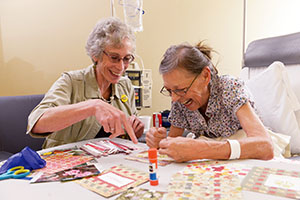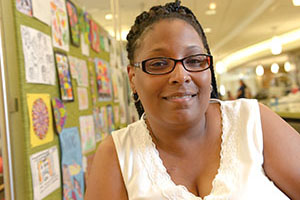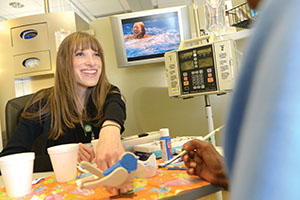By ELLEN FUTTERMAN
It was love at first sight, says Jamie Dansicker, recalling two years ago when she first volunteered to help outpatient chemotherapy patients at Mercy Medical Center in Baltimore work on art projects while they underwent treatment for cancer.

Artist-in-residence Andrea ‘Andy’ Cooper, left, and Becky Bosen work on an art project as Bosen undergoes outpatient chemotherapy at the Institute for Cancer Care at Mercy Medical Center in Baltimore.
"I was only supposed to come in for four hours, but I fell in love with the patients, the clinicians (on the floor) and the program," says Dansicker, 34. "I was hooked. I said, 'You're not getting rid of me so fast.'''
Today, Dansicker has graduated from volunteer to artist-in-residence at Mercy. Every Wednesday and Friday, she meets with chemotherapy patients, helping them to bead jewelry, paint birdcages, decorate picture frames or any other number of art projects designed to brighten their moods and distract them from the tedium of hours-long treatments.
New patients, she says, may resist working with her at first because they are too sick or just uninterested. "Typically, I'll sit and talk to them for a while so we can get to know one another," she says. Eventually, most warm up to her or one of the other artists and wind up truly enjoying making art together.
Art of accommodation
"What we do in our art program at Mercy is aimed at improving the total well-being of the patient as an individual beyond the medical aspects of their treatment," explains Andrea "Andy'' Cooper, one of the other artists-in-residence who helped start the program in 2008. "Sometimes their hands are numb or encumbered by an IV, and I work around that.
"The art making is always a welcome humanizing activity — women especially love to make bracelets and earrings — but sometimes talking about what's important or meaningful in someone's life, like family, a pet, travel or a hobby, can also be a comforting and therapeutic activity on its own. Oftentimes, such discussions will lead to an art activity later on."

Chemotherapy patient Monet Chester says she discovered her creative side making jewelry while receiving chemotherapy treatments at Mercy.
Monet Chester knows this firsthand. She credits "Miss Andy" as she calls Cooper, with being a "kindred spirit," and serving as a calming influence during Chester's chemotherapy treatments. Chester has follicular lymphoma, a type of non-Hodgkin lymphoma that typically occurs in elderly patients, though Chester was diagnosed with it three years ago, when she was 36 years old.
"Miss Andy helped me discover creativity inside of me that I never knew," says Chester, who had worked as a phlebotomist until her illness. "She told me I was different — that I didn't create beaded jewelry like anyone else.
"Talking with her while working on jewelry together really took me outside of myself," she continues. "Miss Andy always has a big smile and gets along with everyone. You just perk up and feel better when you hear her voice."
Chester says she especially enjoyed beading bracelets and necklaces, and has received a lot of positive reviews on her work from friends and family. So much so, she's thinking about creating a website to sell them.
Drawing a smile
Mark Bailey, director of community engagement and volunteer programs at Mercy, says the art therapy program is extremely popular, and he suspects that the personalities of the three artists-in-residence, as well as another artist volunteer, have a lot to do with that. While the program is funded through a grant from "a grateful patient," what the artists do goes "well beyond anything they are compensated for," he says.
"This includes coming in days other than when they are designated to be here to visit patients and distract them and/or entertain them in other ways," he adds. "Andy is also a guitarist/vocalist who offers this talent up on the unit to patients and their families. The artists are all very generous with their time and really brighten a patient's day."
Jessica Payne, a clinical social worker at Mercy, says watching the artists taught her how healing art can be.
"I have seen very withdrawn, depressed patients smile for the first time when having the opportunity to create with our artists," she says. "Their work really brings light and hope to our patients during such a trying time in their lives. It's an opportunity for connection and creativity during their treatments and long days at Mercy. I consider it such an amazing gift to both patients and staff."
Spiritual and mental well-being
Sr. Helen Amos, RSM, executive chair of the hospital's parent, Mercy Health Services, says the art therapy program is a perfect example of how healing the sick is about more than just medicine. A patient's spiritual and mental health are important as well.
"In our mission statement we identify ourselves as a community of compassionate care," says Sr. Amos.

Artist-in-residence Jamie Dansicker works with a chemotherapy patient at Mercy.
"A program like art therapy fits in because taking care of people who are very sick is a multidimensional endeavor. Of course the clinicians are front and center, but there are also the people who take care of the environment, prepare and serve the food … as well as the gifts of people whose work feeds the spirit, which of course includes our visual artists. It takes an entire community to surround patients with a sense of compassionate care."
She also notes that in addition to art therapy, Mercy has a music therapy program that brings a harpist to the chemotherapy unit several times a week.
Mutual inspiration
"You know, people ask me all the time, 'Isn't it depressing working with cancer patients?' But it's the opposite of depressing," says Dansicker, who worked as a fashion designer after college. Next year, she plans to attend nursing school because of her experience at Mercy.
"I have heard so many amazing stories of courage and witnessed such strength and resilience working here," she says.
"Through the art projects, we talk and we also laugh a lot.
"Just the other day a patient who finished chemo told me she would miss coming to the hospital because of our time together making art."
Copyright © 2014 by the Catholic Health Association
of the United States
For reprint permission, contact Betty Crosby or call (314) 253-3477.